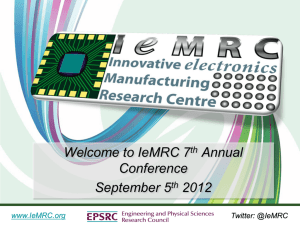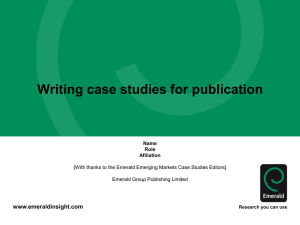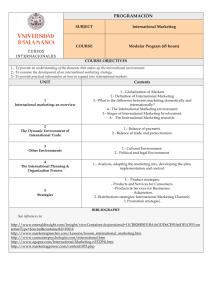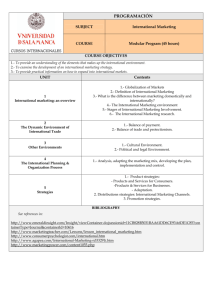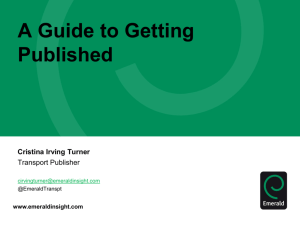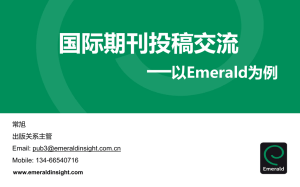Financial Management Essentials
advertisement
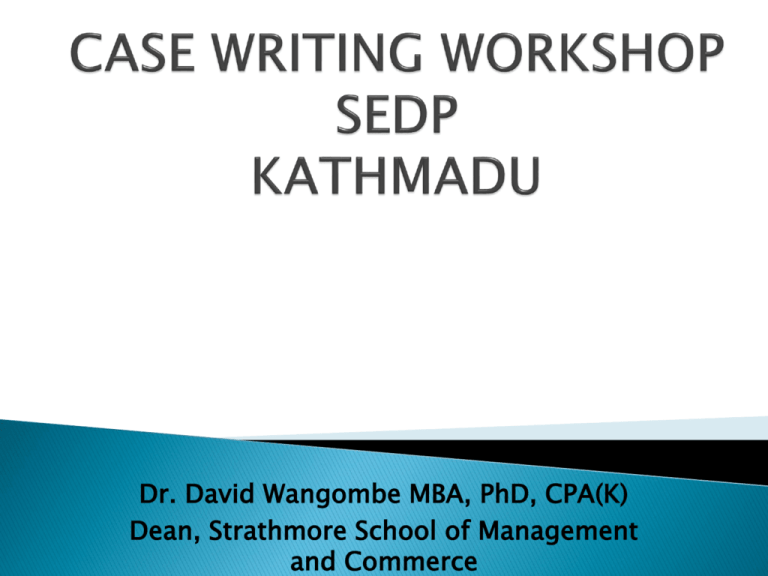
Dr. David Wangombe MBA, PhD, CPA(K) Dean, Strathmore School of Management and Commerce Connecting case to Curriculum Once More: What is a Case Differences between teaching/learning and research cases Writing and structuring a case What makes a good case and common mistakes What is the role of student in your class How does case help achieve that role Learning outcomes Curriculum-Subject-Topic- Case Other material Outline of topics Outline of pre-reading Activities in Class Learning material Exercises The group effect NOT a summary of the events at a company. NOT a research paper. In a business case, just present the information without leading students to a conclusion. NOT a marketing tool for the featured organization A teaching tool that tells a story about a situation that an organization faced. Designed to be solved through classroom discussion, there is no “right” answer. Central decision point, or dilemma, is crucial. A central figure (often a CEO/Minister) that has to make this decision in a given time frame. 6 The Classic Case: ◦ ◦ ◦ ◦ ◦ Organized around a problem, challenge, dilemma Detailed description of real situation Intensive Holistic vision of situation Timeframe The Short Case (Mini-Case, Caselet): ◦ Short, focused description of real situation. . . teaser 7 Specific evaluation cases Specific decision cases General evaluation and appraisal cases ◦ Describes what an organization has done. ◦ Purpose: to understand and evaluate the company’s actions. ◦ Organization faces a specific problem. ◦ Purpose: to consider alternative actions and arrive at a decision. ◦ Case includes unstructured information. ◦ Purpose: evaluation, appraisal and recommendation. 1. 2. 3. 4. 5. 6. 7. Identify your teaching objectives Gather information from credible sources Create an outline First Draft Second Draft Citations Publishing After discussing this case, students will be able to… Defend, justify, explain, determine… After discussing this case study, students will be able to ◦ empathize with the frustration and pain felt by urban residents using transportation in cities around the world ◦ assess the business opportunities for SMART's Integrated Mobility Hub, which offers a more efficient and environmentally and socially sustainable transportation system ◦ make a pitch for PPP project to an investment firm 10 Bloom’s Taxonomy, revised Affective learning Self-direction Responsibility for learning Oral presentation Communication Cooperation Citizenship Active, social learning “…the students strive to resolve questions that have no single right answer. Their differing views and approaches produce a creative tension that fuels the enterprise and a synergistic outcome that both recognizes and exceeds their individual contributions. In their effort to find solutions and reach decisions through discussion, they sort out factual data, apply analytical tools, articulate issues, reflect on their relevant experience, and draw conclusions they can carry forward to new situations. ◦ Boehrer, J. and M. Linsky. “Teaching with Cases: Learning to Question.” In M.D. Svinicki (ed.), The Changing Face of College Passive Learning Active Learning Receive ideas Offer ideas Answer questions Raise questions Hearing analyses Making analyses Examining texts Engaging texts Accepting assumptions Challenging assumptions Faculty-Student dialogue Student-Student dialogue Faculty locus Student locus Writing cases ◦ ◦ ◦ ◦ ◦ ◦ Backwards design Open ended, no one right answer Presents enough information for analysis Presents, not evaluates problem Allows for multiple realistic positions Use and edit Student cases ◦ Experience with cases in class ◦ Heightens benefits of case teaching ◦ Best cases 1. Learning/ Research Objectives. 2. Identify Case Lead through documents, interviews, observations. 3. Establish which documents/ people you will need access and gain access. 4. 5. 6. Collect information on case through further documents, interviews, observation. Write case and get permission to publish. Write the Instructor/ Teaching Notes. Try out the case to see if there is enough information. Teaching/ Learning Cases: ◦ facilitate training, knowledge-sharing ◦ have a story line that group can get immersed in and relate to ◦ highlight practical applications of theory ◦ reflect the ambiguity of the situation and need not have a single outcome, the intent being to create a dialogue, encourage critical thinking and lead to research and evaluation of recommendations. Research Cases: ◦ An in depth look at a particular situation, event, entity. ◦ A methodology used to inform quantitative research findings/ identify areas where more quant is needed. - Associated with qualitative research, ethnography, field study, and participant observation Past tense Identify and establish an issue/problem which can be used to teach/ explore a concept or theory The opening paragraph : WHO is the main protagonist? WHO is the key decision maker? WHAT is the nature of the issue/problem? WHEN did the case take place? Specify the date line in this paragraph. ◦ WHERE did the case take place; what organization? ◦ WHY did the issue/problem arise? ◦ ◦ ◦ ◦ Body of the Case ◦ Tell the whole story - usually in a chronological order ◦ It typically contains general background on macro environment, organisational background, and the details of the specific issue(s) faced. ◦ Tell more than one side to the story so that learners can think of competing alternatives. Concluding Paragraph ◦ Provide a short synthesis of the case to reiterate the main issues, or even to raise new questions. 1. Should be a case not a story 2. Should tackle a relevant and important issue 3. Voyage of discovery 4. Controversy 5. Contrast and compare 6. Currently useful generalizations 7. Data to tackle not solve the problem 8. Personal touch 9. Well structured and easy to read 10. Pertinent topic Reference: “What makes a good case” by Prof. Derek Abell, Professor Emeritus, ESMT Emerald Group Publishing Limited Founded in 1967 in Bradford, West Yorkshire For academics by academics Emerald Emerging Markets Case Studies collection – a welcome addition to our emerging markets content. 150 + peer-reviewed teaching cases from and about the world’s most exciting economies. All Business and Management disciplines covered. Partners include: CEEMAN; AIB MENA; AABS. EEMCS authors enjoy wide international dissemination: 11000+ downloads in the first year. Main publishing contact: Victoria Buttigieg vbuttigieg@emeraldinsight.com “We are really grateful for the comprehensive and thorough review of our case.” [From authors currently in the review process] Ensure the manuscript is checked and edited so that it reads as one voice Exploit your individual strengths Agree and clarify order of appearance of authors and the person taking on the role of corresponding author Distributing work Leader Extending your work http://www.emeraldinsight.com/products/new/pdf/author_guidelines.pdf Plagiarism is hard to detect with peer review but there are new tools to help us Emerald’s entire portfolio is included in iThenticate web-based software from iParadigms http://www.ithenticate.com/ Emerald’s Plagiarism Policy can be seen at http://info.emeraldinsight.com/about/polici es/plagiarism.htm For more general information visit http://www.plagiarism.org/ As the author, you need to ensure that you get permission to use content you have not created as soon as your manuscript has been accepted otherwise this may delay your paper being published Supply written confirmation from the copyright holder when submitting your manuscript If permission cannot be cleared, we cannot republish that specific content More information including a permissions checklist and a permissions request form is available at: o http://www.emeraldinsight.com/authors/writing/best_practice_guide.htm o http://www.emeraldinsight.com/authors/writing/originality.htm It is important that the organisation you have written about is happy for the case to be published. Form to be downloaded, completed and signed by rep from firm. Without the form, you will need to disguise the case. Let someone else see it – show a draft to friends or colleagues and ask for their comments, advice and honest criticism We are always too close to our own work to see its failings Always proof-check thoroughly – no incorrect spellings, no incomplete references. Spell checkers are not foolproof Spot the error: “A knew research methodology introduced in 2007…” Ask a trainer to test it. If they can use it with no further support or supplementary material then it works! Educator Try, test, improve teaching case Submit through ScholarOne Respond to reviewers’ feedback Editorial Team EiC, Regional Editors, EAB and reviewers Solicit new cases Handle review process; support authors Promote collection to peers Develop collection Develop new partnerships Publishing team Production Users Access via Sub or Pay per view Use teaching case in class Editorial Office: Initial checks of manuscript and permissions. The regional editors identify and contact reviewers. The regional editors assess the reviewers' comments and recommendations and recommend a decision. The editor-in-chief makes the final decision. Deadline: 3rd June 2013 http://www.emeraldinsight.com/research/aw ards/ceemancase.htm http://www.emeraldinsight.com/authors/editing _service/index.htm As the author, you need to ensure that you get permission to use content you have not created for when you submit your manuscript otherwise this may delay your paper being published Supply written confirmation from the copyright holder when submitting your manuscript If permission cannot be cleared, we cannot republish that specific content More information including a permissions checklist and a permissions request form is available at: http://www.emeraldinsight.com/authors/writing/best_practice_guide.htm http://www.emeraldinsight.com/authors/writing/permissions.htm Let someone else see it – show a draft to friends or colleagues and ask for their comments, advice and honest criticism We are always too close to our own work to see its failings Always proof-check thoroughly – no incorrect spellings, no incomplete references. Spell checkers are not foolproof Spot the error: “A knew research methodology introduced in 2007…” www.isiwebofknowledge.com (ISI ranking lists and impact factors) www.harzing.com (Anne-Wil Harzing's site about academic publishing and the assessment of research and journal quality, as well as software to conduct citation analysis) www.scopus.com (abstract and citation database of research literature and quality web sources) www.cabells.com (addresses, phone, e-mail and websites for a large number of journals as well as information on publication guidelines and review information) www.phrasebank.manchester.ac.uk (a general resource for academic writers, designed primarily with international students whose first language is not English in mind) http://www.esrc.ac.uk (impact toolkit) You will be advised of one of four possible decisions: - Accept - Minor revision - Major revision - Reject A request for revision is good news! It really is You are now in the publishing cycle. Nearly every published case is revised at least once Don’t panic! Even if the comments are sharp or discouraging, they aren’t personal Acknowledge the editor and set a revision deadline If you disagree, explain why to the editor Clarify understanding if in doubt – ‘This is what I understand the comments to mean…’ Consult with colleagues or co-authors and tend to the points as requested Meet the revision deadline Attach a covering letter which identifies, point by point, how revision requests have been met (or if not, why not) For example “The change will not improve the case because…” Don’t give up! Everybody has been rejected at least once Ask why, and listen carefully! Most editors will give detailed comments about a rejected case. Take a deep breath, and listen to what is being said Try again! Try to improve the case and re-submit. Do your homework and target your case as closely as possible. Keep trying! Incentive to improve your work Valuable feedback Good experience of how the system works Congratulations!! Following a lot of hard work and at least one revision your case has been accepted. Other important publishing work that you might wish to get involved in includes: Reviewing Journal articles Book authorship Editorial advisory board membership Contributing editorship Regional editorship Editorship Partnering organization Have a clear idea of objectives from the start. Develop a productive relationship with organisation. Follow author guidelines. Use your network, publisher, editor for advice and feedback. Instructional Materials http://www.emeraldinsight.com/products/case_studies/index.htm http://www.emeraldinsight.com/authors/guides/write/case.htm http://books.emeraldinsight.com/display.asp?ISB=9781849509220 Competitions EEMCS- AIB MENA Case Writing Competition International Case Writing Competition CEEMAN case writing competition AABS case writing competition ASFOR case writing competition Let someone else see it – show a draft to friends or colleagues and ask for their comments, advice and honest criticism We are always too close to our own work to see its failings Always proof-check thoroughly – no incorrect spellings, no incomplete references. Spell checkers are not foolproof Ask a trainer to test it. If they can use it with no further support or supplementary material then it works! Thank you
